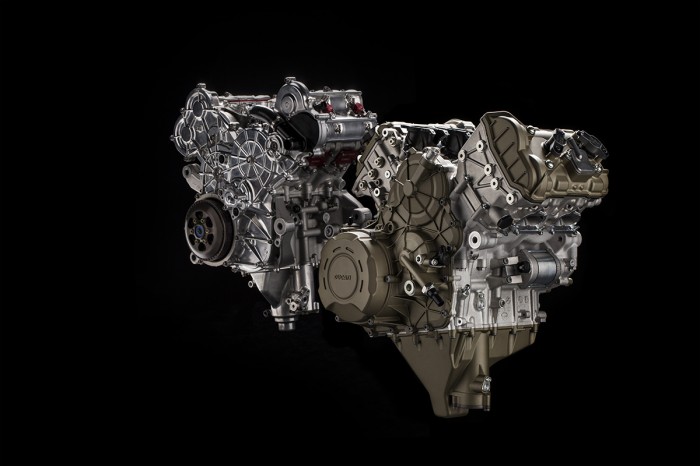Ducati bosses have unveiled the V4 Stradale engine they are banking will take them to WorldSBK success in 2019.
The motor is a 1100cc 90° V4 with an output that ‘exceeds’ 210bhp at 13,000rpm features a counter-rotating crank - as seen in all MotoGP engines - which has a twin-pulse firing order. It has been developed as a road engine and a race version, which won’t be seen until the end of next season, will be a sleeved-down 1000cc R derivative to remain within technical regulations - a clever ploy to stop people racing it before the factory team.
It is designed around the Desmodromic system that controls the four valves in each cylinder and plays a key role in making Ducati prototypes the fastest in MotoGP. On this high-revving engine, the Desmo system achieves a degree of sophistication, lightness and compactness never before seen on a Ducati.
As in MotoGP, the engine was designed with an 81mm cylinder bore. This measurement reflects the maximum limit allowed by MotoGP rules; it’s also the highest in the four-cylinder supersport segment. Using the same bore as the Desmosedici GP engine means both power units share nearly identical in-engine fluid dynamics (i.e. on valves, intake ducts and throttle bodies, right where the power is produced).
Just the facts, ma’am:
1,103 cm³ four-cylinder 90-degree V engine
Bore x stroke 81 x 53.5 mm
Compression ratio 14:1
Maximum power exceeds 155 kW (210 hp) at 13,000 rpm
Maximum torque exceeds 120 Nm (12.2 kgm) from 8,750 to 12,250 rpm
Euro 4 emissions
Desmodromic part chain, part gear [timing with dual overhead camshaft, 4 valves per cylinder
Counter-rotating crankshaft with crank pins offset at 70°
Wet multiplate anti-patter servo clutch
Semi-dry sump lubrication with four oil pumps: 1 delivery and 3 return
Fuelling with four oval throttle bodies (52 mm diameter equivalent) and variable-height intake horns
Six-speed gearbox with DQS up/down system
24,000 km “Desmo Service” maintenance interval (15,000 miles)
Compared to a classic in-line four, the lateral compactness of the V arrangement allows for better mass centralization and reduces the bike’s frontal cross-section. Moreover, the shorter crankshaft diminishes the gyroscopic effect. All these aspects have a positive impact on motorcycle dynamics, making it lighter and faster when changing direction. Ample space inside the V provides room for both the water pump and an outsize airbox (12.8 litres) that lets the Desmosedici Stradale breathe better.
Smooth integration of engine and chassis set-up forms the foundation of every Ducati. That’s why the Desmosedici Stradale is designed to be banked rearward 42°, just like the Ducati engines used in MotoGP. This optimises weight distribution, allows for larger radiators and brings the swingarm pivot as far forward as possible.
Moreover, the Desmosedici Stradale has been designed as a structural chassis element. The main frame attachment points have been incorporated in the front of the upper crankcase half and in the rear cylinder bank head. What’s more, the crankcase acts as a rear suspension and swingarm attachment point.
Twin-pulse ignition
A combination of 70° crank pin offset and 90-degree V layout generates what Ducati calls a Twin Pulse firing order because it’s as if the engine were reproducing the firing sequence of a twin-cylinder. The distinctiveness lies in the fact that the two left-hand cylinders fire closely together, as do the two right-hand ones. In the timing chart, the ignition points are, then, at 0°, 90°, 290° and 380°. It’s this particular firing order makes the V4 sound like a MotoGP Desmosedici.
Imagine a cycle starting from 0°, the first cylinder to fire is the front one on the alternator side. After just 90° of rotation, the rear cylinder on the same side fires. There then follows an interval in which the engine generates no drive torque until the two cylinders on the clutch side fire, again just 90° apart. In addition to an exhaust rumble like no other in the motorcycle world, the Twin Pulse ignition sequence provides a power delivery that Ducati MotoGP riders deem unbeatable as it provides outstanding engine performance and, therefore, smooth handling, especially on corners and out-of-the-corner stretches.
Counter-rotating crank
On normal bikes, the crankshaft turns in the same direction as the wheels. In MotoGP, counter-rotating crankshafts that run in the opposite direction are widely used. Ducati engineers have borrowed this top-level racing solution for the same reasons that first saw it applied in competition. Its benefits stem from two aspects of physics: gyroscopic effect and inertia.
A counter-rotating crankshaft offsets some of the gyroscopic effect generated by the turning wheels and that, in turn, improves handling and makes the bike more agile when changing direction.
The second benefit has to do with the inertia (i.e. the tendency of an object to oppose any change of state) of the vehicle and the rotating engine parts. During acceleration, drive torque is put down on the ground, causing the bike to wheelie. A counter-rotating crankshaft, however, produces inertia-linked torque in the opposite direction, lowering the front of the bike, limiting the wheelie effect and thus boosting acceleration performance.
Similarly, during hard braking/deceleration the bike undergoes rear wheel lift-up: however, the crankshaft itself also decelerates (i.e. its revs drop), producing an inertial torque that works against lift-up. So a counter-rotating crankshaft has advantages during both acceleration and braking.
This layout demands the addition of a jackshaft to transfer crankshaft drive through the gearbox to the rear wheel so it turns the right way.


